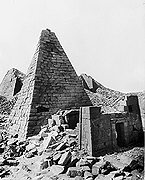
- INTRODUCTION
- 1987 Exhibition Brochure - NUBIA "Its glory and its people"
- 1992 Exhibition Brochure - VANISHED KINGDOMS OF THE NILE: The Rediscovery of Ancient Nubia
INTRODUCTION
The Oriental Institute participated in the UNESCO international salvage excavation project in the reservoir area of the Aswan High Dam in Upper Egypt in 1960-64. The project was directed by Keith Seele, Professor of Egyptology at the Institute. The expedition was based on the former Cook tourist boat "Fostat", accompanied by another houseboat, the "Barbara", a tug boat, and a motor launch, all purchased and modified to provide mobile housing, laboratories and storage space. In the first season the project produced an epigraphic record of the Beit El-Wali Temple, near the High Dam. In subsequent seasons the expedition moved its little fleet up the Nile to a new concession between the temples at Abu Simbel and the border of the Sudanese Republic. Excavations were conducted in a monastery, at habitation sites, and in a number of cemeteries extending for miles along both banks of the Nile. These excavations contributed information on every period of Egyptian Nubia from the Old Kingdom through Coptic times.
After the death of Professor Seele in 1971, the Institute initiated a project to complete the publication of the results of the Egyptian Nubia excavations. The publication project was entrusted to Bruce Williams, Ph.D., a graduate of the University of Chicago in Egyptology. The first two volumes were published before Williams was assigned to the project. Since then Williams has completed eight monumental monographs (1986-93) that will stand as the fundamental sources for the archaeology and history of Egyptian Nubia. Williams is currently working on two additional volumes. Another two volumes are also in preparation by collaborators, including one Ph.D. dissertation. Williams has devoted his entire academic career to the Nubia publications. His dedication is admirable and the Institute takes pride in the fact that the Nubia publication project is near completion.
Because the Nubian expedition was a part of the UNESCO salvage project, the Egyptian Government granted export license for a large collection of objects recovered by the expedition. These artifacts are now a part of the perminent collection of the Institute and will serve as a valuable resource for generations of scholars as new questions are raised and new techniques of analysis are introduced. Two museum exhibitions of Nubian materials from the collection have been mounted; one of magnificent textiles at the Art Institute, and a fine educational exhibition in the Oriental Institute Museum. The exhibit in our museum, Vanished Kingdoms of the Nile: The Recovery of Ancient Nubia, attracted many enthuiastic new visitors to the museum and received a "Superior Achievement" award from the Congress of Illinois Historical Societies and Museums in 1992, as well as considerable press coverage, including a favorable review in the New York Times.

